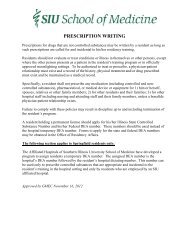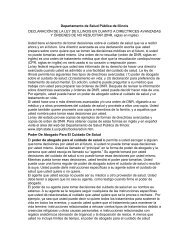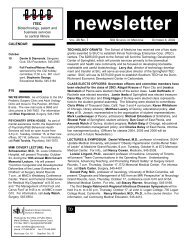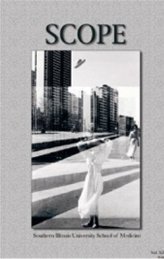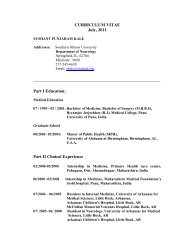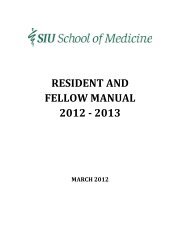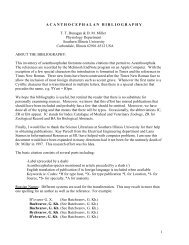Ch. 54 – Biliary System
Ch. 54 – Biliary System
Ch. 54 – Biliary System
Create successful ePaper yourself
Turn your PDF publications into a flip-book with our unique Google optimized e-Paper software.
Surgery for Calculous <strong>Biliary</strong> Disease<br />
Laparoscopic <strong>Ch</strong>olecystectomy<br />
Since the introduction of laparoscopic cholecystectomy,<br />
the number of cholecystectomies performed in the United<br />
States has increased from about 500,000 per year to<br />
700,000 per year. Contraindications to laparoscopic cholecystectomy<br />
include coagulopathy, severe chronic<br />
obstructive pulmonary disease, end-stage liver disease,<br />
and congestive heart failure. Currently, the major contraindication<br />
to completing a laparoscopic cholecystectomy<br />
is inability to clearly identify all of the anatomic structures.<br />
The conversion rate for elective laparoscopic<br />
cholecystectomy should be around 5%, whereas the conversion<br />
rate in the setting of acute cholecystitis may be<br />
as high as 30%. Conversion to an open procedure is not<br />
a failure, and the possibility should be discussed with the<br />
patient preoperatively.<br />
Patients undergoing laparoscopic cholecystectomy<br />
should be prepared and draped in a similar fashion to<br />
open cholecystectomy. The patient is supine on the operating<br />
table with the surgeon standing on the patient’s left.<br />
The pneumoperitoneum is created with carbon dioxide<br />
gas, either with an open technique or by closed-needle<br />
technique. With the open technique, a small incision is<br />
made either above or below the umbilicus into the peritoneal<br />
cavity. A special blunt-tipped cannula (Hasson)<br />
with a gas-tight sleeve is inserted into the peritoneal<br />
cavity and anchored to the fascia. This technique is often<br />
used following previous abdominal surgery and should<br />
Right<br />
subcostal<br />
lateral<br />
and medial<br />
instrument<br />
positions<br />
Fundus of<br />
gallbladder<br />
<strong>Ch</strong>apter <strong>54</strong> <strong>Biliary</strong> <strong>System</strong> 1563<br />
avoid infrequent but life-threatening trocar injuries. In the<br />
closed technique, a special hollow insuffl ation needle<br />
(Veress) with a retractable cutting sheath is inserted into<br />
the peritoneal cavity through a periumbilical incision and<br />
used for insuffl ation. There is no difference in inadvertent<br />
bowel or tissue injury between the two techniques.<br />
The laparoscope with the attached video camera is<br />
then inserted into the umbilical port and the abdomen<br />
inspected. The additional ports are inserted under direct<br />
vision (Fig. <strong>54</strong>-14). The medial 5-mm cannula is used<br />
to grasp the gallbladder infundibulum (Fig. <strong>54</strong>-15) and<br />
retract it laterally with the pull toward the right pelvis, to<br />
expose the triangle of Calot; it is important to widely<br />
expose the triangle of Calot with this direction of retraction<br />
to fully enable identifi cation of possible aberrant<br />
biliary anatomy. This maneuver may require taking down<br />
the adhesions between the omentum or duodenum and<br />
the gallbladder. Most of the dissection can be performed<br />
using a dissector, hook, or scissors. The junction of the<br />
gallbladder and cystic duct is identifi ed and dissection<br />
continued until the cystic artery and duct is clearly seen<br />
entering the gallbladder (Fig. <strong>54</strong>-16). A helpful anatomic<br />
landmark is the cystic lymph node. Careful extended<br />
dissection of the base of the gallbladder off the liver bed<br />
is essential to defi ne the duct and artery. The outdated<br />
infundibular technique of cystic duct dissection and identifi<br />
cation does not fully expose the triangle of Calot and<br />
leads to misidentifi cation and is a setup for bile duct<br />
injury. Partial dissection of the base of the gallbladder off<br />
the liver bed before dividing either the artery or cystic<br />
Liver<br />
Cystic duct<br />
and<br />
artery<br />
Subxiphoid<br />
instrument<br />
position<br />
Figure <strong>54</strong>-15 The gallbladder is retracted cephalad using the grasper on the gallbladder fundus and at the infundibulum,<br />
with the direction of pull toward the right pelvis. The peritoneum overlying the gallbladder infundibulum<br />
and neck and the cystic duct is divided bluntly, exposing the cystic duct. (From Cameron J: Atlas of Surgery, vol<br />
2. Philadelphia, BC Becker, 1994.)



